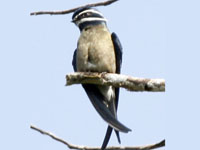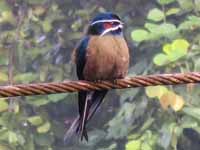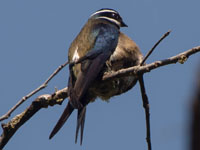The swifts are a family, Apodidae, of highly aerial birds. They are superficially similar to swallows, but are actually not closely related to passerine species at all. Swifts are in the separate order Apodiformes, which they share with hummingbirds. The treeswifts are closely related to the true swifts, but form a separate family, the Hemiprocnidae. Swifts use their short legs only for clinging onto vertical surfaces or wires, and never land on the ground voluntarily.Because of this, and also because they usually fly fast and sledom alight, they are difficult to photograph. Often the best way to identify a swift is by where it is found.
Genus Aerodramus
These small swifts nest in caves. Unique among swifts, they use echolocation which enables them to navigate in caves. Because saliva is used to make the nests, some people consider them edible.
Swiftlet,_Ameline Aerodramus amelis Found: Philippines
The Ameline Swiftlet is sometimes considered a subspecies of the uniform swiftlet.
Image by: 1) Paul French
Swiftlet,_Atiu Aerodramus sawtelli Found: Atiu in the Cook Islands.
The Atiu has sooty-brown upperparts; slightly paler underparts.
Image by: 1) Biberi 2) McCormack 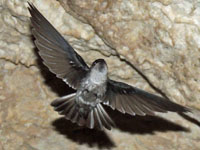
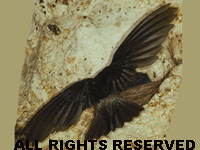
Swiftlet, Australian Aerodramus terraereginae Found: Queensland in northeast Australia
The Australian Swiftlet has gray-bronw upperaprts; grayish underparts; slightly forked tail.
Image by: 1) Tobias Hayashi
Swiftlet,_Bare-legged Aerodramus nuditarsus Found: New Guinea
The Barelegged Swiftlet has dark brown upperparts; pale fringes on lores and above eyes; sooty gray underparts.
Image by: 1) Katerina_Tvardikova 2) Salvatore Chamu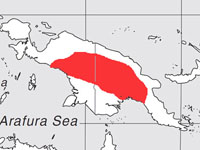

Swiftlet, Black-nest Aerodramus maximus Found: southeast Asia
The Black-nest Swiftlet is found in Brunei, Indonesia, Malaysia, Myanmar, the Philippines, Singapore, Thailand, and Vietnam.
Image by:
1) Wokoti 2) Lim_Chan_Koon - Malaysia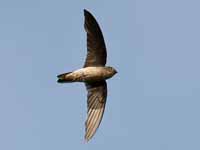
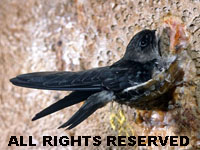
Swiftlet,_Caroline_Islands Aerodramus inquietus Found: Caroline Islands (near Guam)
The Caroline Islands Swiftlet is also known as the Island Swiftlet and the Micronesian Swiftlet.
Image by: 1) Biodiversity_Heritage_Library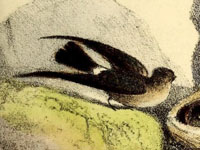
Swiftlet, Germain's Aerodramus germani Found: China, Indonesia, Malaysia, Philippines
The Germain's Swiftlet has blackish-brown upperparts; much paler underparts. Several calls are uttered including a loud zwing and various chip calls used for echolocation in dark caves.
Image by: 1) Ron Knight - Thailand 2) Jerry Oldenettel - Thailand
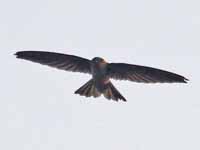
Swiftlet, Himalayan Aerodramus brevirostris Found: Himalayas and southeast Asia
The Himalayan Swiftlet has mainly gray-brown upperparts; paler brown underparts; pale gray rump; pale patch above and below bill.
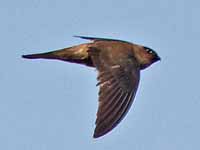
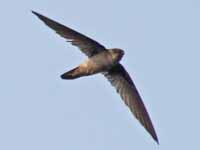
Swiftlet, Indian Aerodramus unicolor Found: Sri Lanka and southwest India
The Indian Swiftlet has mainly dark brown upperparts; paler brown underparts; short and slightly indented tail
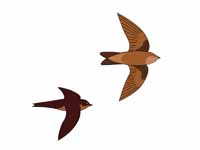
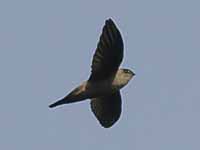

Swiftlet, Mariana Aerodramus inquietus Found: Guam, Northern Mariana Islands, Oahu (introducedi)
The Mariana has dark gray-brown upperparts, head; gray-white throat, upper-breast; darker gray rest of underparts.

Swiftlet,_Mascarene Aerodramus francicus Found: Islands in Indian Ocean
The Mascarene Swiftlet is found in Mauritius and Réunion.
Image by: 1) Kevin Le Pape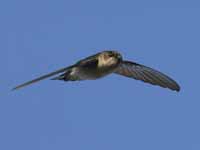
Swiftlet,_Mayr's Aerodramus orientalis Found: New Guinea, Solomon Islands
The Mayr's Swiftlet was formerly conspecific with Whitehead's Swiftlet.
Image by: 1) Katerina_Tvardikova 2) hbw.com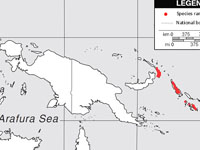

Swiftlet,_Mossy-nest Aerodramus salangana Found: Indonesia
The Mossy-nest Swiftlet is found in northern Borneo, the Natuna and the Derawan Islands, islands off western Sumatra and Java. Also consider subspecies of Uniform Swiftlet
Image by:
1) Paul Jones 2) Bernard_Dupont - Malaysia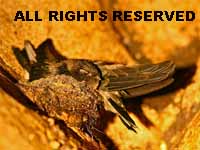
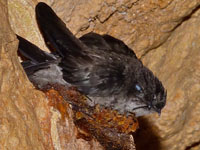
Swiftlet,_Mountain Aerodramus hirundinaceus Found: New Guinea
The Mountain Swiftlet has dark brown upperparts; moderately forked tail; pale-gray to mild-gray underparts.
Image by: 1) Katerina_Tvardikova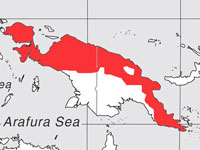
Swiftlet,_Palau Aerodramus pelewensis Found: Palau
Palau is in the western chain of the Caroline Islands.
Image by: 1) Devon_Pike
Swiftlet,_Philippine Aerodramus mearnsi Found: Philippines
Image by: 1) Salvatore Chamu

Swiftlet,_Polynesian Aerodramus leucophaeus Found: Tahiti and Moorea
The Polynesian Swiftlet is also known as the Tahiti Swiftlet. It has dark brown upperpart with gray rump.
Image by: 1) hbw.com
Swiftlet,_Seram Aerodramus ceramensis Found: Seram Indonesia and other islands
The Seram Swiftlet has blackish-brown upperparts; rump slightly paler; pale brown underparts; forked tail. It is found on Buru, Seram, Boano and Ambon Island.
Image by: 1, 2) James Eaton - Seram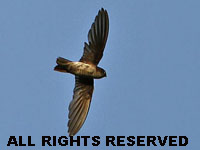

Swiftlet,_Seychelles Aerodramus elaphrus Found: Seychelles Islands in the Indian Ocean.
The Seychelles Swiftlet has dark gray-brown upperparts; slightly paler rump; pale gray underparts; darkest on under-tail coverts; black legs.
Image by: 1) Post_of_Seychelles
Swiftlet,_Sulawesi Aerodramus sororum Found: Sulawesi of Indonesia
The Sulawesi Swiftlet was formerly considered a subspecies of the Moluccan swiftlet.
Image by: 1) James_Eaton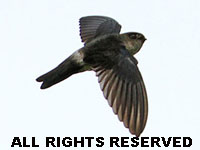
Swiftlet,_Three-toed Aerodramus papuensis Found: New Guinea
The Three-toed Swiftlet has brown upperparts, rump; slightly forked tail.
Image by: 1) Katerina_Tvardikova 2) Salvatore Chamu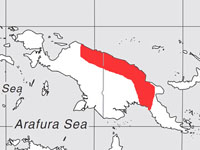

Swiftlet, Uniform Aerodramus vanikorensis Found: Indonesia, Papua New Guinea
The Uniform Swiftlet has dark gray-brown upperparts; paler gray-brown lowerparts; even paler chin, throat.
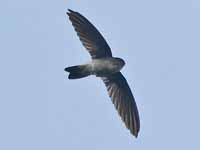
Swiftlet,_Volcano Aerodramus vulcanorum Found: Java of Indonesia
The Volcano Swiftlet formerly considered conspecific with the Himalayan Swiftlet.
Image by: 1) hbw.com
Swiftlet,_Whitehead's Aerodramus whiteheadi Found: Philippines
The Whitehead's Swiftlet was
named after the British explorer John Whitehead (1860-1899) who collected natural history specimens in Borneo and elsewhere in Southeast Asia.
Image by: 1) Rob_Hutchinson
Swiftlet,_White-nest also Edible-nest Swiftlet Aerodramus fuciphagus Found: southeast Asia
The White-nest Swiftlet has blackish-brown upperparts; paler rump, underpart; slightly forked tail; black legs.
Image by: 1) Cactus26 2) Lip Kee
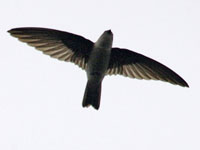
Swiftlet,_White-rumped Aerodramus spodiopygius Found: islands southeast of New Guinea
The White-rumped Swiftlet is found in American Samoa, Fiji, New Caledonia, New Guinea, Samoa, Solomon Islands, Tonga, and Vanuatu. The Australian Swiftlet used to be conspecific with it.
Image by: 1) Katerina_Tvardikova 2) McCormack - Fiji

Genus Aeronautes
Swift, Andean Aeronautes andecolus Found: Argentina, Boliva, Chile, Peru
Image by: 1) Alcide 2) Pablo Contreras
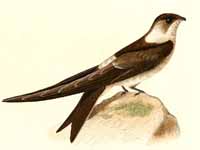

Swift, White-throated Aeronautes saxatalis Found: The Americas
The White-throated Swift is distinguished from other North American swifts by the whitish throat patch, which extends down to the belly. The upperparts, belly, and sides of the breast are black, and the underwings are gray.
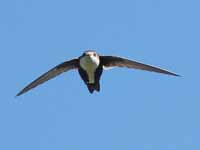
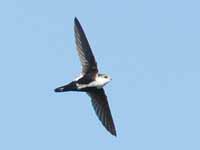
Swift, White-tipped Aeronautes montivagus Found: subtropical and tropical forests of South America
The White-tipped Swift is found in Argentina, Bolivia, Brazil, Colombia, Ecuador, Guyana, Peru, and Venezuela.
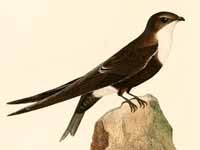
Genus Apus
Swift, African Apus barbatus Found: south Africa, Madagascar
The African Swift. also known as African Black Swift, has blackish-brown plumage with a pale gray chin patch.
Similar to: Common Swift. African Swift has a black back compared to its blackish-brown wings; Common Swift back and wings have no contrast in color. African Swift is heavier than Common Swift which results in a steady level flight interspersed with short glides.
Image by: 1) Trevor HardakarSimilar to: Common Swift. African Swift has a black back compared to its blackish-brown wings; Common Swift back and wings have no contrast in color. African Swift is heavier than Common Swift which results in a steady level flight interspersed with short glides.
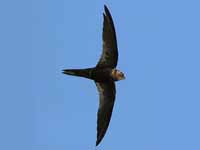
Swift,_Alexander's Apus alexandri Found: Cape Verde
The Alexander's Swift is also known as the Cape verde Swift. Cape Verde is 350 miles off west coast of Africa.
Image by: 1) Dave_Barnes
Swift,_Bates's Apus batesi Found: western Africa
The Bate's Swift has glossy black upperparts; deeply forked tail often held closed to form a point.
Image by: 1) hbw.com
Swift,_Blyth's Apus leuconyx Found: Asia
The Blyth's Swift has mainly black plumage with white rump, white throat patch. It is also considered a subspecies of the Pacific Swift. Blyth's swifts breeds from the outer Himalayas through the Assam hills. This species is migratory, and winters in India and Sri Lanka.
Image by: 1) Subhadeep_Ghosh 2) Christoph_Moning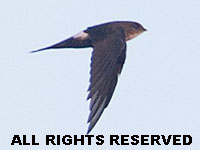
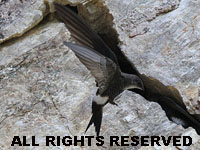
Swift, Bradfield's Apus bradfieldi Found: southern Africa
Image by: 1) Alan Manson - South Africa
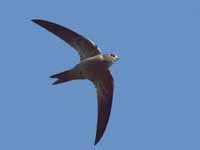
Swift, Common Apus unicolor Found: Europe, Asia, Africa
The Common Swift has mainly blackish-brown plumage; pale gray patch on chin; short forked tail.
Similar to: African Swift. African Swift has a black back compared to its blackish-brown wings; Common Swift back and wings have no contrast in color. African Swift is heavier than Common Swift which results in a steady level flight interspersed with short glides.
Similar to: Little Swift. Common Swift has forked tail; Little Swift has square tail.
Similar to: Pacific Swift. Pacific Swift has white rump band, Common Swift does not.
Similar to: Plain Swift. Common Swift has pale gray patch on chin; Plain Swift does not.
Image by: 1) Vardion 2) Pau Artigas - Spain 3) Ferran Pestana - Gambia 4) Mark Kilner - England 5) Ian White - BotswanaSimilar to: African Swift. African Swift has a black back compared to its blackish-brown wings; Common Swift back and wings have no contrast in color. African Swift is heavier than Common Swift which results in a steady level flight interspersed with short glides.
Similar to: Little Swift. Common Swift has forked tail; Little Swift has square tail.
Similar to: Pacific Swift. Pacific Swift has white rump band, Common Swift does not.
Similar to: Plain Swift. Common Swift has pale gray patch on chin; Plain Swift does not.
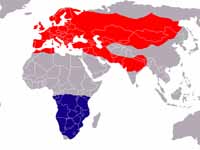
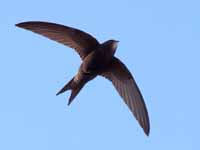

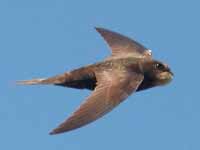
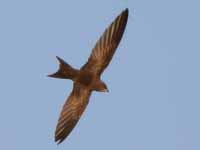
Swift, Cook's Apus cooki Found: mainland southeast Asia
Cook's Swift has mainly blackish plumage with narrow white rump band.
Similar to: Pacific Swift. The White rump band is narrower on the Pacific Swift than on the Pacific Swift. Cook's Swift does not migrate as far.
Image by: 1) Graham EkinsSimilar to: Pacific Swift. The White rump band is narrower on the Pacific Swift than on the Pacific Swift. Cook's Swift does not migrate as far.

Swift,_Dark-runped Apus acuticauda Found: mainly northeast India; also Thailand
The Dark-rumped Swift is found in Northeast India and is a vagrant to Thailand.
Image by: 1) Anwaruddin_Choudhury
Swift,_Forbes_Watson Apus berliozi Found: Kenya, Somalia, Yemen
Image by: 1, 2) Tommy_Pedersen
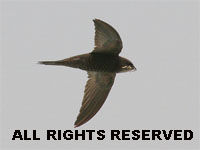

Swift, Horus Apus horus Found: sub-Saharan Africa
The Horus Swift has mainly blackish plumage; white chin patch, rump.
Image by: 1) Robert Wienand 2) Carol Foil - Lake Navasha, Kenya
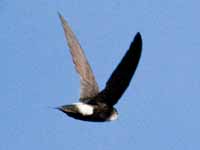
Swift,_House Apus nipalensis Found: Japan, Nepal, southeast Asia
The House Swift was formerly considered a subspecies of the Little Swift.
Image by: 1) Opisska 2) 2015 Hank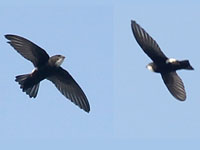
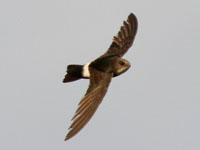
Swift, Little Apus affinis Found: Africa, Asia
The Little Swift has mainly black plumage; white rump.
Similar to: Common Swift. Common Swift has forked tail; Little Swift has square tail.
Similar to: White-rumped Swift. The White-riumped Swift is slimmer, darker, and has a more forked tail than Little Swift.
Image by: 1) JM Garg 2) Peter Steward - KenyaSimilar to: Common Swift. Common Swift has forked tail; Little Swift has square tail.
Similar to: White-rumped Swift. The White-riumped Swift is slimmer, darker, and has a more forked tail than Little Swift.
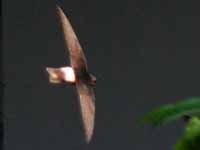
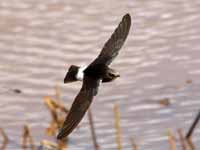
Swift,_Madagascar Apus balstoni Found: Madagascar
The Madagascar Swift is also known as the Malagasy Black Swift.
Image by: 1) Werner_Suter
Swift,_Nyanza Apus niansae Found: Africa
The Nyanza Swift is found in Eritrea, Ethiopia, Kenya, Somalia, South Sudan, Tanzania, and Uganda.
Image by: 1) Salvatore Chamu 2) Sergey_Yeliseev
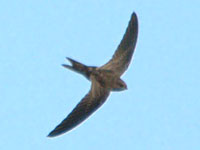
Swift, Pacific also Fork-tailed Swift Apus pacificus Found: eastern Asia to Australia
The Pacific Swift has mainly blackish plumage with white rump band.
Similar to: Common Swift. Pacific Swift has white rump band, Common Swift does not.
Similar to: Cook's Swift. The White rump band is narrower on the Pacific Swift than on the Pacific Swift. Cook's Swift does not migrate as far.
Image by: 1) Robert Pudwell 2) KC HungSimilar to: Common Swift. Pacific Swift has white rump band, Common Swift does not.
Similar to: Cook's Swift. The White rump band is narrower on the Pacific Swift than on the Pacific Swift. Cook's Swift does not migrate as far.
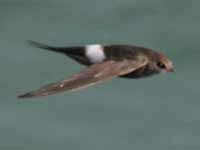
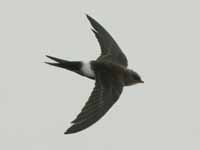
Swift,_Pallid Apus pallidus Found: Africa, Asia
The Pallid Swift has brown plumage; paler underparts; short forked tail; long wings. Pallid swifts breed on cliffs and eaves around the Mediterranean and on the Canary Islands and Madeira, laying two eggs. Like swallows, they are migratory, winter in southern Africa or southeast Asia.
Image by: 1) stavros_karabinas 2) Bogbumper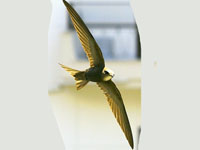
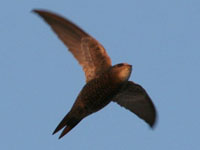
Swift, Plain Apus unicolor Found: Canary Islands, Madeira, northwest Africa
The Plain Swift has blackish-brown plumage; short forked tail.
Similar to: Common Swift. Common Swift has pale gray patch on chin; Plain Swift does not.
Image by: 1) Frode Falkenbur - Morocco 2) fotoemin - Canary IslandsSimilar to: Common Swift. Common Swift has pale gray patch on chin; Plain Swift does not.
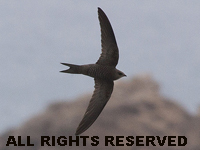

Swift,_Salim_Ali's Apus salimalii Found: Asia
The Salim Ali's Swift has dark plumage; white rump. Salim Ali's swifts breed from the eastern Tibetan Plateau eastwards through western Sichuan province. This species is migratory, however its wintering range is unknown. It is also considered a subspecies of the Pacific Swift.
Image by: 1) James_Eaton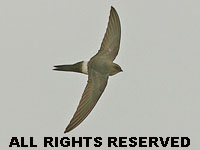
Swift, White-rumped Apus caffer Found: Europe, north Africa
The White-rumped Swift has mainly dark plumage; white rump, throat.
Similar to: Little Swift. The White-riumped Swift is slimmer, darker, and has a more forked tail than Little Swift.
Image by: 1) Waxbill 2) Victor 3) Ian WhiteSimilar to: Little Swift. The White-riumped Swift is slimmer, darker, and has a more forked tail than Little Swift.
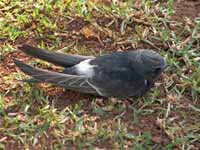
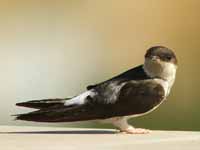
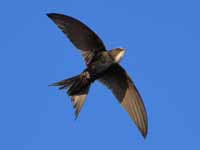
Genus Chaetura
Swift,_Amazonian Chaetura viridipennis Found: Bolivia, Brazil, Colombia, Ecuador, Peru.
The Amazonian Swift was was formerly treated as a subspecies of the more northerly distributed Chapman’s Swift. These two species probably largely replace one another north and south of the Amazon. The Amazonian Swift is also known as the Mato Grosso Swift.
Image by: 1) hbw.com - Chapman's Swift
Swift,_Band-rumped Chaetura spinicaudus Found: Found: southern Central America, South America
The Band-rumped Swift was considered conspecific with the Costa Rican Swift. It has blackish upperparts; broad white band across rump; dark brown upperparts with paler throat; short tail.
Image by:
1) Dave Curtis - Guyana 2) Joao_Quental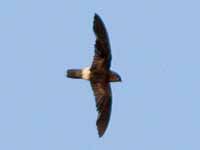
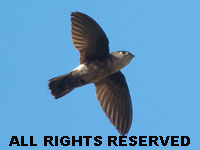
Swift, Chapman's Chaetura chapmani Found: Panama, Trinidad, Tobago, northern South America
The Chapman's Swift was formerly treated as conspecific with the more southerly distributed Amazonian Swift. These two species probably largely replace one another north and south of the Amazon.
Image by:
1) Dave Curtis - Guyana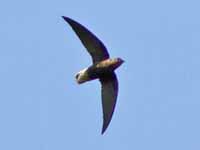
Swift, Chimney Chaetura pelagica Found: The Americas, Europe
In flight, this bird looks like a flying cigar with long slender curved wings. The plumage is a sooty grey-brown; the throat, breast, underwings and rump are paler. They have short tails.
Image by: 1) Ed Schipul - Texas 2) USNPS 3, 4) Jim McCullock - Texas 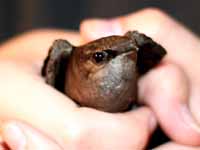
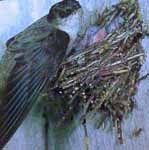
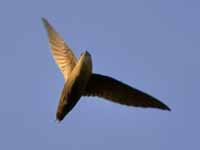

Swift, Costa Rican Chaetura fumosa Found: Columbia, Costa Rica, Panama
The Costa Rican Swift has mainly sooty black plumage with a contrasting pale rump band. Its bill and feet are black in comparison to the Band-rumped Swift.
Image by: 1) Oscar Johnson - Costa Rica
Swift,_Gray-rumped Chaetura cinereiventris Found: South America
The Gray-rumped Swift has black upperparts with gray trianguler band across the rump; long black-gray tail.
Image by: 1) José Daniel Avendaño
Swift,_Lesser_Antillean Chaetura martinica Found: Lesser Antilles
The Lesser Antillean Swift has blackish-brown upperparts with a paler rump. It breeds on Dominica, Guadeloupe, Martinique, Saint Lucia and Saint Vincent.
Image by: 1) Don_Faulkner
Swift, Pale-rumped Chaetura egregia Found: Bolivia, Brazil, Ecuador, Peru
The Pale-rumped Swift is best separated from similar species such as the Gray-rumped Swift by the obviously paler rump, the shorter wings, and to some extent the bronze-colored gloss to the plumage.
Image by:
1) Claudio Timm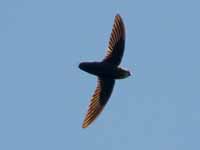
Swift, Short-tailed Chaetura brachyura Found: tropical South America
The Short-tailed Swift has mainly black upperparts with a pale rump and tail. It can be distinguished from related species in its range, such as the Band-rumped Swift or the Gray-rumped Swift by the lack of contrast between the rump and the tail, the latter being much darker in the other species.
Image by:
1) Claudio Timm 2) Hector Bottai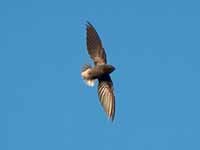
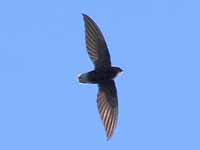
Swift, Sick's Chaetura meridionalis Found: South America
The Sick's Swift has dark smoky-brown upperparts; ashy gray tail with dark shafts and protruding spines; gray throat; dark brown lower underparts; black bill, legs.
Image by:
1) Claudio Timm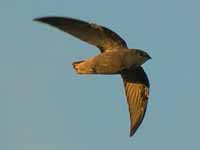
Swift, Vaux's Chaetura vauxi Found: North America, northern South America
The Vaux's Swift has dusky black upperparts, head, wings; grayish-brown tail coverts; paler throat becoming white in northern birds.
Image by: 1) Jamie Chavez - California 2) Jerry Oldenettel - New Mexico
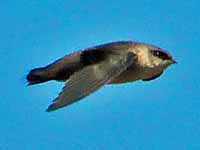
Genus Collocalia
Swiftlet,_Bornean Collocalia dodgei Found: northern mountains of Borneo
The Bornean Swiftlet is tiny with relatively short wings and a square tail. It has mainly dark gray to black plumage; white belly.
Similar to: Glossy Swiftlet. The Bornean Swiftlet is slightly smaller than the Glossy Swiftlet with a greenish rather than bluish gloss to feathers.
Image by: 1) Dave Irving - Mount Kinabalu, Sabah, Borneo.Similar to: Glossy Swiftlet. The Bornean Swiftlet is slightly smaller than the Glossy Swiftlet with a greenish rather than bluish gloss to feathers.
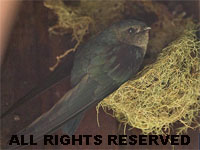
Swiftlet, Cave Collocalia linchi Found: Indonesia, Malaysia
The Cave Swiftlet has blackish-brown upperparts; dark upper-breast; pale gray lower-breast, belly
Image by: 1) Lip Kee - Java, Indonesia 2) Dave Irving - Borneo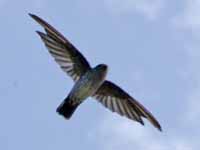

Swiftlet, Glossy Collocalia esculenta Found: southeast Asia to Australia
The Glossy Swiftlet has glossy blue-black upperparts; black upper-breast; pale lower-breast, belly. Nests insides caves and building. Attaches nest by sticky substance it secretes.
Similar to: Bornean Swiftlet. The Bornean Swiftlet is slightly smaller than the Glossy Swiftlet with a greenish rather than bluish gloss to feathers.
Image by: 1) Lip Kee - Bali, Indonesia 2) Thomas Brown - MalaysiaSimilar to: Bornean Swiftlet. The Bornean Swiftlet is slightly smaller than the Glossy Swiftlet with a greenish rather than bluish gloss to feathers.


Swiftlet,_Pygmy Collocalia troglodytes Found: Philippines
Image by: 1) Allen_Desmond 1, 2) Allen_Desmond - Cebu


Genus Cypseloides
Swifts of this genus nest on canyon walls or vertical cliff faces and lay only one egg. In breeding season it tends to be found near waterfalus and gorges.
Swift,_Black Cypseloides niger Found: The Americas
In flight, this bird looks like a flying cigar with long slender curved wings. The plumage is mostly a sooty dark gray. There is some contrast between the upper and lower wing. The shoulders are much darker in color than the remaining portion of the wing. They also have short slightly forked tails.
Image by: 1) Biodiversity_Heritage_Library 2) Terry Gray - Idaho 3) Aaron_Maizlish
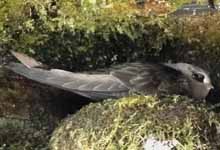
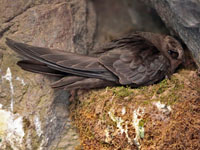
Swift,_Great_Dusky Cypseloides senex Found: Argentina, Bolivai, Brazil, Paraguay
The Great Dusky Swift is large relative to other swifts, and dark brown in color with a pale coloured head.
Image by:
1) Tom Stephenson 2) Ron_Knight - Argentina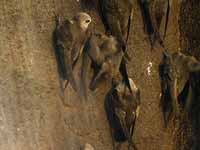
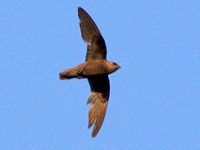
Swift,_Rothschild's Cypseloides rothschildi Found: mainly northwest Argentina; also Bolivia
The Rothschild's Swift has medium brown plumage; long broad wings; short square-ended tail. Formerly considered conspecific with the Rothschild's Swift.
Image by: 1) hbw.com
Swift, Sooty Cypseloides fumigatus Found: Argentina, Bolivai, Brazil, Paraguay
The Sooty Swift is medium-sized, blackish brown swift with a square tail. Formerly considered conspecific with the Sooty Swift.
Image by: !) Francesco Veronesi - Brazil 2) Paulo_Ricardo_Fenalti

Swift,_Spot-fronted Cypseloides cherriei Found: Colombia, Costa Rica, Ecuador, Venezuela
The Spot-fronted Swift has large white lores; small white patch behind eye. Little is known about its population.
Image by: 1) Andres_Cuervo 2) Luke_Seitz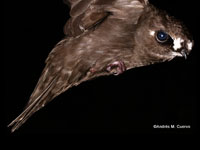
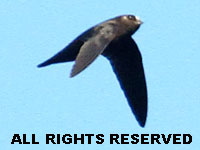
Swift,_White-chested Cypseloides lemosi Found: Columbia, Ecuador, Peru
The White-chested Swift has been seen only infrequently. The size and distribution of its population is not well known.
Image by: 1) Tim Avery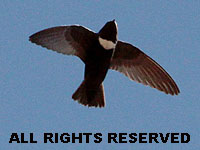
Swift,_White-chinnned Cypseloides cryptus Found: Central America, Columbia, Peru, Venezuela
The White-chinned Swift has a spotty distribution, but this might be because it is infrequently seen. Identification is helped if there are other swiifts nearby for comparison.
Image by: 1) Anselmo d'Affonseca 2) Juan Pablo Lopex-Ordonez 3) Michael_Andersen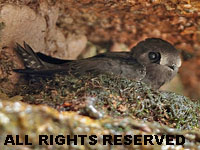
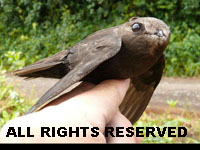

Swift,_White-fronted Cypseloides storeri Found: Mexico
The White-fronted Swift is separated from other swifts only by virtue of its strikingly uniform plumage, proportionately shorter, square-ended tail, broad-winged, chunky-bodied, and relatively large-headed appearance. Very similar to the Chestnut-collared Swift.
Image by: 1) hbw.com
Genus Cypsiurus
Swift, African Palm- Cypsiurus parvus Found: Africa, Madagascar
The African Palm-Swift has long swept-back wings that resemble a crescent or a boomerang. The body is slender, and the tail is long and deeply forked, although it is usually held closed. The call is a loud, shrill scream.
Image by: 1) Dawadi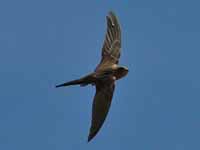
Swift, Asian Palm- Cypsiurus balasiensis Found: southeast Asia, Indonesia, Malaysia, Philippines
The Asian Palm-Swift has mainly plain brown plumage; long and deeply forked tail which is usually closed to a point; loud shrill scream.
Image by:
1) Jerry Oldenettel - Thailand 2) Dhanatas Thovanich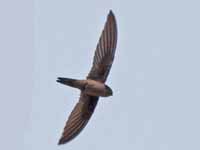

Genus Hirundapus
These needletailed swifts get their name from the spiny ends to the tail.
Needletail, Brown-backed Hirundapus giganteus Found: India east to Indonesia and Philippines
The Brown-backed Needletail has mainly dark brown plumage with white under-tail.
Image by: 1) Jerry Oldenettel - Thailand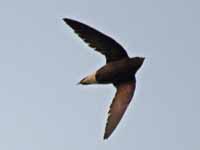
Needletail, Purple Hirundapus celebensis Found: Indonesia, Philippines
The Purple Needletail has black throat, breast, upper-belly; white lower-belly, undertail; purple under-wings. A very large swift. Can also be recongnized by lack of pale throat patch.
Image by: 1, 2) Neon Rosell

Needletail,_Silver-backed Hirundapus cochinchinensis Found: China, India, Southeast Asia, Indonesia, Malaysi
The Silver-backed Needletail is found in Cambodia, China, India, Indonesia, Laos, Malaysia, Myanmar, Nepal, Singapore, Thailand, and Vietnam. It is a vagrant to Christmas Island.
Image by: 1) Fran_Trabalon - Taiwan
Needletail, White-throated also Needle-tailed Swift Hirundapus caudacutus Found: Asia, Australasia
The White-throated Needletail has mainly black plumage with white throat and under-tail.
Image by: 1) BioDivLib 2) Tom Tarrant - Queensland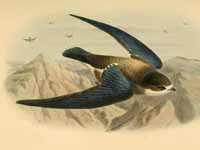

Genus Hydrochous - 1 species
Swift,_Waterfall Hydrochous gigas Found: Indonesia, Malaysia
The Waterfall Swift is also known as the Large Swift.
Image by: 1) hbw.com
Genus Mearnsia
Swift,_Papuan_Spine-tailed Mearnsia novaeguineae Found: New Guinea
The Papuan Spine-tailed Swift has glossy blue-black upperparts, head, under-wing; white or whitish belly.
Image by: 1) Markus_Lilje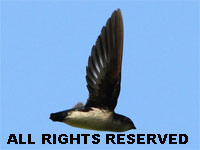
Needletail,_Philippine also Philippine Spine-tailed Swift Mearnsia picina Found: Philippines
The Philippine Spine-tailed Swift's natural habitat is subtropical or tropical moist lowland forests. It is becoming rare due to habitat loss.
Image by:
1) Joseph Smit 2) Stijn_De_Win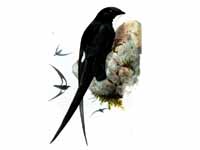

Genus Neafrapus
Spinetail,_Bohm's also Bat-like Spinetail Neafrapus boehmi Found: Africa
The Bohm's Spinetail is found in Angola, Botswana, DRC, Kenya, Malawi, Mozambique, Namibia, Somalia, South Africa, Tanzania, Zambia, and Zimbabwe. It occurs in the vicinity of Baobab trees and nests in cavities in the trees.
Image by: 1) Johann du Preez - Zambia 2) Nigel Voaden 3) Maans_Booysen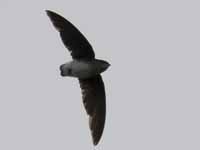

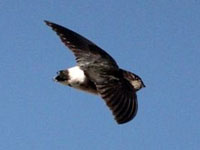
Spinetail, Cassin's Neafrapus cassini Found: Africa
The Cassin's Spinetail is found inAngola, Cameroon, Central African Republic, Republic of the Congo, DRC, Ivory Coast, Equatorial Guinea, Gabon, Ghana, Liberia, Nigeria, Sierra Leone, and Uganda.
Image by: 1) Joseph Wolf? 2) Graham Ekins - Uganda 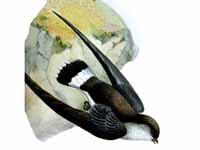

Genus Panyptila
Swift, Lesser Swallow-tailed Panyptila cayennensis Found: Mexico to Brazil
The Lesser-Swallow-tailed Swift has mainly black plumage; white throat, upper-breast; sqarish white patches on rear flanks; long narrow wings; long forked tail.
Image by:
1) Michael Woodruff - Ecuador 2) Tom Benson - Panama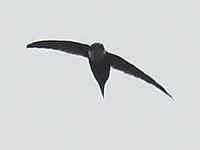

Swift, Great Swallow-tailed Panyptila sanctihieronymi Found: Mexico, Central America
The Great Swallow-tailed Swift is found in Costa Rica, Guatemala, Honduras, Mexico, and Nicaragua.
Image by:
1) Joseph Wolf 2) John van Dort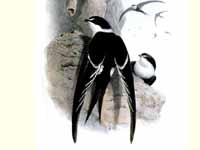

Genus Rhaphidura
Spinetail, Sabine's Rhaphidura sabini Found: Africa
Image by: 1) Graham Ekins - Uganda

Spinetail,_Silver-rumped Rhaphidura leucopygialis Found: southeast Asia, Indonesia, Malaysia
The Silver-rumped Spinetail is found in Brunei, Indonesia, Malaysia, Myanmar, Singapore, and Thailand. It is also called the Silver-rumped Needletail. Note the narrow spine-like projection protruding from the tail in image 1)
Image by: 1) John Mittermeier 2) Ayuwat_Jearwattanakanok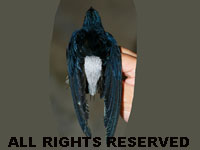
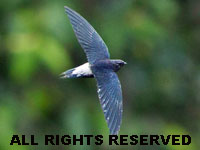
Genus Schoutedenapus
Swift,_Scarce Schoutedenapus myoptilus Found: Africa
The Scarce Swift is found mainly in Kenya, DR Congo, South Africa, Tanzania, Uganda, Zimbabwe. It has a deeply forked tail.
Image by: 1) Martin Goodey 2) Per_Holmen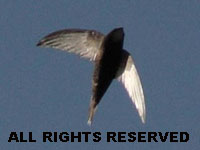
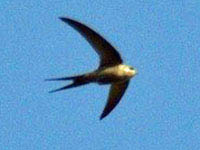
Swift,_Schouteden's Schoutedenapus schoutedeni Found: Democratic Republic of Congo
The Schouteden's Swift has a deeply forked tail. Its s common name and Latin binomial commemorate the Belgian zoologist Henri Eugene Schouteden..
Image by: 1) hbw.com
Genus Streptoprocne
Swift,_Biscutate Streptoprocne biscutata Found: eastern Brazil, northeast Paraguay
The Biscutate Swift has blackish-brown plumage; incomplete white collar.
Image by:
1) Joseph Wolf 2) Claudio Timm 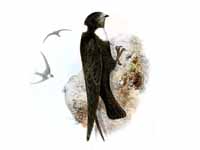
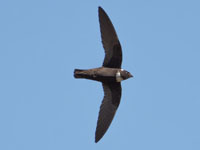
Swift,_Chestnut-collared Streptoprocne rutila Found: Mexico and Trinidad south to Peru and Bolivia
The male Chestnut-collared Swift has blackish plumage with a rufous collar. In females and immatures the rufous collar is incomplete or absent.
Image by: 1) Steve Garvie - Trinidad 2) Brian Sullivan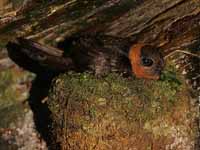

Swift,_Tepui Streptoprocne phelpsi Found: Brazil, Guyana, Venezuela
The Tepui Swift has reddish feathering on head, neck; orange throat and collar (paler in females).
Image by: 1) hbw.com
Swift, White-naped Streptoprocne semicollaris Found: Mexico
The White-naped Swift has a white collar, Its tail is considerably less forked than the similar White-collared Swift.
Image by: 1) Joseph Smit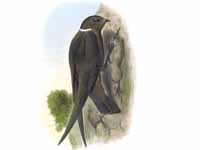
Swift, White-collared Streptoprocne zonaris Found: Central America and South America
The White-collared Swift has black with blue gloss back; white collar which is broader and duller on the breast than the hindneck; slightly forked tail that may appear square.
Image by:
1) Claudio Timm 2) Tommy Pederson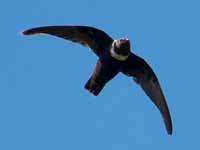

Genus Tachornis
Swift, Antillean Palm- Tachornis phoenicobia Found: Caribbean
The Antillean Swift has black upperparts with a white rump; white throat and much of underparts.
Image by: 1) Jerry Oldenettel - Cuba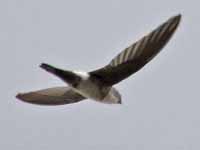
Swift, Fork-tailed Palm- also Neotropical Palm-Swift Tachornis squamata Found: Columbia, Venezuela, Peru, Brazil
The western form has black-brown upperparts with a slight greenish gloss; paler brown underparts; white throat and central underbody. Eastern race has steel-black upperparts; darker brown underparts. They feed on low flying insects, usually less than 10 meters above the ground.
Image by: 1) Joseph Wolf 2) Dave Curtis - Guyana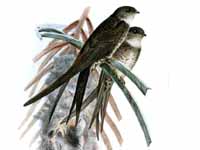
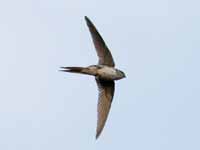
Swift,_Pygmy Tachornis furcata Found: Columbia, Venezuela
The Pygmy Swift, also known as the Pygmy Palm-Swift; has brown upperparts; whitish throat; brown breast; whitish belly.
Image by: 1) hbw.com
Genus Tachymarptis
Often included in genus Apus those of Tachymarptis are larger, host a different speices of feather lice, and have markedly differnet DNA.
Swift, Alpine Tachymarptis aequatorialis also Apus alexandri Found: Europe, Asia, Africa
The Alpine Swift has mainly dark brown plumage; white breast, upper-belly. Twice as large as other swifts in its range.
Similar to: Barn Swallow, House Martin.
Image by: 1) Birdwatching Barcelona 2) Dave CurtisSimilar to: Barn Swallow, House Martin.
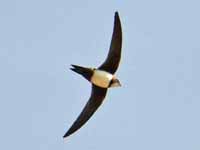
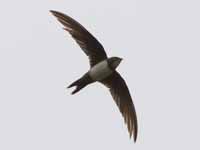
Swift,_Mottled Tachymarptis aequatorialis Found: Africa
The Mottled Swift occurs widely in eastern Africa and locally in western Africa.
Image by: 1) Per Holmen 2) Martin_Grimm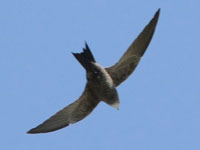
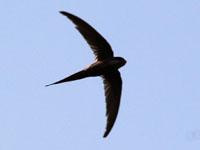
Genus Telacanthurar
Spinetail,_Black Telacanthura melanopygia Found: Africa
The Black Spinetail is found in Angola, Cameroon, Central African Republic, Republic of the Congo, Democratic Republic of the Congo, Ivory Coast, Gabon, Ghana, Liberia, Nigeria, and Sierra Leone.
Image by: 1) Werner_Suter - Cameroon
Spinetail, Mottled Telacanthura ussheri Found: Africa
Image by: 1) John Gerrard Keulemans 2) Johan van Rensburg
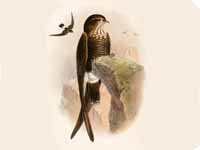

Genus Zoonavena
Spinetail, Malagasy Zoonavena grandidieri Found: Comoros, Madagascar, Mayotte
The Malagasy Spinetail is the only spinetail on Madagascar and Comoros.
Image by: 1) Kristian Svennson 
Spinetail, Sao Tome Zoonavena thomensis Found: off western equatorial coast of Africa
The Sao Tome Spinetail is found on the islands of São Tomé, São Tomé and Príncipe.
Image by:
1) John Gerrard Keulemans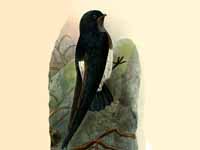
Spinetail, White-rumped Zoonavena sylvatica Found: Western Ghats (west India mountain range)
The White-rumped Spinetail is often seen over waterbodies in the middle of forest. It can resemble a House Swift but has a white vent.
Image by:
1) Kannan AS - Thattekad, Kerala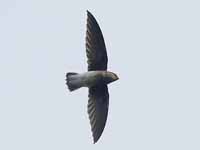
Order Apodiformes Family Hemiprocnidae
The treeswifts are closely related to the "true swifts". They are superficially similar to swallows, but are actually not closely related to passerine species at all. Swifts are in the separate order Apodiformes, which they share with hummingbirds. The treeswifts are closely related to the true swifts, but form a separate family, the Hemiprocnidae. The differ from the true swifts having crests or other facial ornaments, and long forked tails.
Genus Hemiprocne
Treeswift,_Crested Hemiprocne coronata Found: southeast Asia
The Crested Treeswift has gray upperparts; white underparts; crest; long and deeply forked tail. Male has orange face.
Image by: 1) JM Garg 2)Kousik Nandy 3, 4) Thimindu Goonatillake1) Pair 2, 3) Female 4) Male
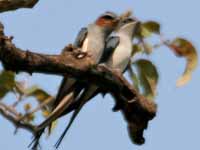
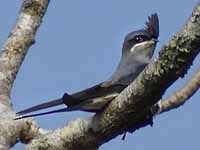
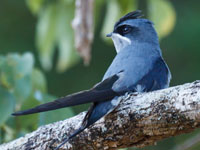

Treeswift,_Gray-rumped Hemiprocne longipennis Found: southeast Asia, Indonesia, Malaysia, Philippines
The Gray-rumped Treeswift has greenish sheen to upperparts; pale gray belly; white belly. Male has orange-red ear coverts; female doesn't.
Image by: 1) John Gould 2) Seshadri 3) Melvin_Yap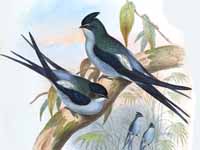

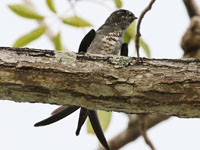
Treeswift,_Moustached Hemiprocne mystacea Found: New Guinea, Solomon Islands
The Moustached Treeswift has white eye-band, moustache /whiskers; white visible on back when wings folded.
Similar to: Whiskered Treeswift. Moustached Treeswift has white visible on back when wings folded; Whiskered Treeswift does not.
Image by: 1) 1) Katerina Tvardikova 2) Tony Morris - Solomon Islands 3) Jerry_Oldenettel - New GuineaSimilar to: Whiskered Treeswift. Moustached Treeswift has white visible on back when wings folded; Whiskered Treeswift does not.
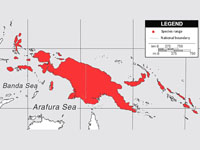
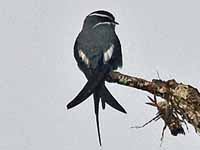
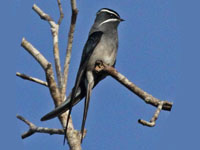
Treeswift,_Whiskered Hemiprocne comata Found: southeast Asia, Indonesia, Malaysia, Philippines
The Whiskered Treeswift has white eye-band, moustache /whiskers.
Similar to: Moustached Treeswift. Moustached Treeswift has white visible on back when wings folded; Whiskered Treeswift does not.
Image by: 1) Lip Kee - Malaysia 2) Cristian Holland 3) Jason_Thompson - ThailandSimilar to: Moustached Treeswift. Moustached Treeswift has white visible on back when wings folded; Whiskered Treeswift does not.
